You are currently browsing the tag archive for the ‘Frederick Stock’ tag.
Six degrees of separation is the theory that all people are no more than six social connections away from each other. It is usually used to connect living individuals, but we also can stretch it back to link people through history.
Throughout his career, Riccardo Muti has been connected to the music of Ludwig van Beethoven. During his tenure as the Chicago Symphony Orchestra’s tenth music director, he has conducted all of the composer’s major orchestral works—including the nine symphonies—and he will conclude his tenure with the monumental Missa solemnis. So, how might Maestro Muti be connected to Beethoven? Let’s find out, perhaps through the historic roster of the Chicago Symphony Orchestra . . .
Beginning with his debut in 1973 and continuing through his tenure as music director, Muti has collaborated with two musicians who hold the record as the longest-serving members of the Chicago Symphony Orchestra: Lynne Turner, second harp, and Jay Friedman, principal trombone. Both were hired by sixth music director Fritz Reiner in October 1962, and in June 2023 both will complete their sixty-first seasons as members of the Orchestra. (The record previously was held by Adolph “Bud” Herseth, who served for fifty-six seasons, fifty-four as principal trumpet.) Turner, who first performed with the CSO as a soloist on youth concerts at the age of fourteen, joined the Orchestra shortly after becoming the first American to win top prize in the International Harp Contest in Israel. Friedman, after four years as a member of the Civic Orchestra of Chicago and two with the Florida Symphony, was hired as assistant principal trombone, and in 1965, he was promoted to principal by seventh music director Jean Martinon.
Turner and Friedman performed for several years alongside colleagues Milton Preves and Frank Crisafulli, each of whom served in the Orchestra for over fifty years and both were hired by second music director Frederick Stock. Preves joined the Orchestra’s viola section in 1934, became assistant principal in 1936 and principal in 1939, remaining in that post for forty-seven years until his retirement in 1986. Crisafulli began his tenure in the trombone section in 1938, serving as principal from 1939 until 1945 and again from 1946 until 1955. He retired in 1989.
Preves and Crisafulli certainly would have known Franz Esser and Hjalmar Rabe, also members of the Orchestra for more than fifty years. Esser joined the violin section at the beginning of the second season in 1892, later serving as principal viola from 1898 until 1926 and principal second violin from 1926 until 1939; he retired in 1945. Rabe joined the violin section in 1895 but also played the bassoon; he was principal of that section for one season, 1918–19, and also principal contrabassoon in his final season, 1944–45.
Of course, both Rabe and Esser were hired by the Chicago Orchestra’s founder and first music director Theodore Thomas.
That brings us up to four degrees: Muti to Turner and Friedman to Preves and Crisafulli to Esser and Rabe to Thomas.
In early 1850, fourteen-year-old Theodore Thomas was performing in New York as a violinist in pit orchestras. He caught the attention of Karl Eckert, who hired him into the Italian Opera Company as leader of the second violins. Eckert was succeeded the following year by composer, violinist, and conductor Luigi Arditi, who promoted Thomas to the role of concertmaster as well as contractor to engage the members of the orchestra. As a member of the Italian company, Thomas had a front-row seat to hear and collaborate with two of the most important musicians of the day: Swedish soprano Jenny Lind (also known as the “Swedish Nightingale” whose American tours were organized and promoted by none other than P.T. Barnum) and German soprano Henriette Sontag.

In 1823, Carl Maria von Weber heard Sontag—then only seventeen—in Vienna, in Rossini’s La donna del lago and offered her the title role in his new opera, Euryanthe, which premiered to great success later that year. Her career continued to flourish as she performed throughout Europe. Her single tour to the United States was in 1852 and included several performances with the Italian Opera Company in New York, with then sixteen-year-old Thomas in the pit.
Thomas expressed in his autobiography: “I do not remember another singer in whom art and experience were combined with such freshness and quality of voice. . . . neither of these exceptional women conquered the world with voice and execution alone. It was the perfection and blending of these qualities, together with the single aim—that of truthful expression, which gave greatness to whatever they rendered. I have never heard their equals.” And according to Thomas’s widow Rose Fay in the Memoirs, “nothing was more helpful to young Thomas [and] at this time the greatest singers the world has ever heard were singing in New York. . . . [Lind and Sontag] possessed the true secret of tone quality, and it occurred to him that the same kind of tone which they produced with the voice could also be created on the violin . . . as he listened to these great artists . . . he endeavored to reproduce their singing, tone for tone, on his beloved instrument.”

Nearly thirty years before her United States tour, eighteen-year-old Henriette Sontag sealed her place in music history. On May 7, 1824, in Vienna, she was the soprano soloist in three sections—Kyrie, Credo, and Agnus Dei—of the Missa solemnis and the premiere of the Ninth Symphony, conducted by the composer, Ludwig van Beethoven.
That’s six degrees of separation, mostly through the Chicago Symphony Orchestra family: Riccardo Muti to Lynne Turner and Jay Friedman to Milton Preves and Frank Crisafulli to Franz Esser and Hjalmar Rabe to Theodore Thomas to Henriette Sontag to Ludwig van Beethoven.
This article also appears here.
The Rosenthal Archives recently received a collection of materials documenting the life of violinist, influential teacher, and member of the Chicago Symphony Orchestra, Leon Sametini.
Sametini was born on March 16, 1886, in Rotterdam, Holland, where his father Samual was principal flute in the Royal Opera Orchestra. He showed early promise on the violin and soon became a protégé of Queen Wilhelmina of the Netherlands, who funded his study with the famed violin pedagogue Otakar Ševčík for one year.
When Sametini was fifteen, the Queen gifted to him an early eighteenth-century Serafin violin and funded his enrollment at the Prague Conservatory from 1902 until 1903. There he continued his studies with Ševčík and with then-director of the conservatory, Antonín Dvořák.
Sametini cited violinist and composer Eugène Ysaÿe as a particularly important influence on his playing, despite not formally studying with him: “It was after I had finished with all my teachers that I really began learning how to play violin: above all from Ysaÿe, whom I went to hear play wherever and whenever I could.”
A year after graduating, Sametini embarked on a decade of international travel, beginning with a six-month concert tour through Holland before moving to London and touring both England and Ireland. In 1905, he first appeared with the renowned soprano Nellie Melba, one of the first Australian classical musicians to win international recognition. Sametini also gave recitals throughout 1907 and 1908 with Australian contralto Ada Crossley and her eponymous Concert Company. Also supporting Crossley in her tour of England was composer and pianist Percy Grainger. With Crossley’s company, Sametini went on to tour Australia and New Zealand, as well as India and Indonesia, in 1908.
In 1912, Sametini departed London for Chicago, where he had accepted a position as the head of the violin department at the Chicago Musical College (now a division of the Chicago College of Performing Arts at Roosevelt University), a position he would hold for the remainder of his life. Soon after his arrival, Sametini rehearsed Brahms’s Violin Concerto with Frederick Stock, and it became clear that there were plans in the works for him to soon perform with the Theodore Thomas Orchestra (as the ensemble was then known).







However, this opportunity came about sooner than anticipated. Mischa Elman was scheduled to perform Saint-Saëns’s Third Violin Concerto with the Orchestra on January 24 and 25, 1913. However, Frederick Wessels, the Orchestral Association’s manager, received a telegram from Elman at 10:11 a.m. on January 24, stating that Elman was “ill with grip [the flu] in hospital, Madison [Wisconsin]. Doctors Head and Jackson refuse to allow me leave, therefore impossible to play today or tomorrow.”
Stock immediately contacted Sametini, who, with mere hours’ notice, replaced Elman and performed Brahms’s Violin Concerto with the Orchestra. In spite of these unfavorable circumstances, the violinist’s dramatic debut was received enthusiastically by Chicago audiences and critics. Sametini earned “much applause and great success,” wrote Maurice Rosenfeld in the Chicago Daily News, and “belongs to the list of brilliant young violin virtuosos. . . . Sametini’s playing of the difficult Brahms concerto disclosed him to be an artist of eminent qualities [with the ] technical equipment of the leading virtuosos of the day.” In the Chicago Tribune, Glenn Dillard Gunn added, “Such a feat inspires respect. It attests to the courage and decision of character as well as to abundant talent and sterling qualities of musicianship. These were the salient elements revealed in [Sametini’s] interpretation.”
Sametini performed a similar act of musical heroism just a week later, on February 2, 1913, with the Chicago Grand Opera Company. He stepped in as a last-minute replacement for Efrem Zimbalist, performing the final two movements of Mendelssohn’s Violin Concerto along with Saint-Saëns’s Introduction and Rondo capriccioso. “Mr. Sametini proved again his right to be reckoned among the foremost artists of he city with a musicianly performance . . singing qualities of tone, with accentuation of rhythm, and with musical phrasing,” wrote the critic in the Chicago Examiner.
The violinist became a frequent soloist across the city and surrounding areas, and Sametini would feature as soloist with the Chicago Symphony Orchestra on two more occasions. On December 20 and 21, 1918, he appeared with the CSO playing Saint-Saëns’s Third Violin Concerto, conducted by Eric DeLamarter. Just over a decade later, on December 28 and 29, 1928, he returned, this time performing Lalo’s Violin Concerto in F minor and Saint-Saëns’s Introduction and Rondo capriccioso under Stock’s baton. At Stock’s invitation, Sametini joined the Orchestra’s first violin section for the 1942-43 season. He died of a heart ailment in Chicago on August 20, 1944, at the age of fifty-eight.

Leon Sametini is best remembered for his contributions as a pedagogue, working with many notable violinists, and his teaching philosophy is reflected in the diverse achievements of his protégés. He encouraged his students to not only consider a career as a soloist, but also to explore the broad range of opportunities available in an orchestra. Sametini recognized the distinct skills required of both the soloist and the orchestral violinist, treating both roles with impartiality and encouraging his students to pursue whichever best played to their strengths.
Writing in The Musical Leader, Sametini expressed his philosophy. “There is every opportunity in this country to become an able musician and a great violinist, and those who do not attain the rank of soloists need not feel that they are any less musicians on that account. Their unique talents simply make them better orchestral musicians than soloists, and who is to say there is any degree of superiority between these two branches of the same art?”
Sametini’s students included many orchestral string players, including several members of the Chicago Symphony Orchestra: William Faldner (violin, 1956–1994), Victor Charbulak (violin, 1922–1967), Samuel Thaviu (violin, 1934–1937), and Sheppard Lehnhoff (viola, 1930–45 and 1953–1978). Milton Preves also studied with Sametini before being appointed to the CSO’s viola section by Frederick Stock, achieving the ranks of assistant principal and principal in 1936 and 1939 respectively, serving until his retirement in 1986. Mildred Brown studied with Sametini in 1915 before becoming a charter member of the Civic Orchestra during the 1919–20 season. Brown was invited to return to the Civic by Stock in 1922, becoming the ensemble’s first female concertmaster. Fred Spector, another of Sametini’s students, also was concertmaster of the Civic before joining the CSO’s first violin section in 1956, serving until his retirement in 2003. Sametini also taught composer and violinist Silvestre Revueltas, whose works have been performed by the Orchestra on several occasions.
The Leon Sametini Collection in the Rosenthal Archives contains the violinist and teacher’s collection of musical memorabilia from his decades of performance, including clippings of concert reviews from his years as an international soloist, as well as autographed portraits of his many friends, teachers, and collaborators within the musical world.






This article also appears here.
With her masters in musicology from Northwestern University, Sara Mercurio is an acquisitions assistant for Northwestern’s libraries and an intern in the Chicago Symphony Orchestra Association’s Rosenthal Archives. In the fall of 2023, she will begin a master’s degree in library and information science at the University of Illinois Urbana-Champaign.
Sergei Rachmaninov made his first appearances with the Chicago Symphony Orchestra on December 3 and 4, 1909, conducting his Isle of the Dead and performing as soloist in his Second Piano Concerto with Frederick Stock conducting. For more than thirty years, he regularly appeared in Chicago, both as recitalist and with the Orchestra, performing as soloist in his four concertos and the Rhapsody on a Theme of Paganini and conducting his Third Symphony and choral symphony The Bells.
He first performed his Third Piano Concerto, again with Stock on the podium, on January 23 and 24, 1920. Despite a nasty Chicago storm, Orchestra Hall was packed for the Friday matinee. “The concert of yesterday afternoon was an event,” wrote Karleton Hackett in the Evening Post. “I do not care what the verdict of twenty years from now may be regarding this concerto, for I have just listened to a performance of it that stirred me deeply. . . . It was a work of a man who understands the capacity of the instrument and can write for it in the fresh, vigorous idiom of our day such music as brings out its peculiar power and charm. What is quite as much to the point, he himself can play the instrument with a mastery that makes every phrase a delight. Rachmaninov has supreme virtuosity. There is nothing he cannot do at the keyboard, from the most exquisite delicacy of ornamentation to the downright stroke of elemental power. . . . The music was so vigorous, expressing so spontaneously the emotion of our own time that it seemed as though it were being struck out in the white heat of the creative impulse of the moment.”
In January 1932, the composer was again in Chicago for three concerts with Stock and the Orchestra. After a performance of the second concerto on January 12, Herman Devries in the American reported, “It was not Chicago . . . it was not Orchestra Hall . . . it was not Rachmaninov . . . to me it seemed Olympus, and we were all gods. Thus does music glorify when it is itself glorious. It is not the first time that I have waxed passionately enthusiastic over the genius of Rachmaninov. After hearing Horowitz [in recital] on Sunday [January 10], we thought that the season’s thrills were nearly complete.”
Later that week, on January 14 and 15, Rachmaninov was soloist in his third concerto. “The most exciting event in the history of Orchestra Hall occurred last night,” wrote Glenn Dillard Gunn in the Herald and Examiner. “With one impulse, the audience rose and shouted its approval. Many eyes were wet and many throats were hoarse before the demonstration ended. For once on their feet, the listeners remained to cheering after the Orchestra had trumpeted and thundered its fanfare and long after the composer-pianist had brought Dr. Stock to the footlights to share his honors. Never have I witnessed such a tribute . . . and never, it is my sincere conviction, has such response been so richly deserved.
Rachmaninov’s final appearances with the Orchestra were on February 11 and 12, 1943, in Beethoven’s First Piano Concerto and his Rhapsody on a Theme of Paganini, under the baton of associate conductor Hans Lange. “Sergei Rachmaninov evoked a series of ovations when he appeared with the Chicago Symphony Orchestra at Orchestra Hall last night,” wrote Claudia Cassidy in the Chicago Tribune. “His entrance won standing tribute from orchestra and capacity audience, his Beethoven stirred a storm of grateful applause, and his own Rhapsody on a Theme of Paganini ended the concert in a kind of avalanche of cumulative excitement.”
The following week, Rachmaninov traveled to Louisville and Knoxville for solo recitals on February 15 and 17, in what would be his final public performances. He died in Beverly Hills, California, on March 28, 1943.
This article also appears in the program book for the April 20-23, 2023, concerts and here.
John and Frances Glessner were among the most generous and loyal supporters of the Chicago Symphony since the Orchestra’s founding in 1891. They extended that generosity into their own home in the Prairie Avenue District, and Theodore Thomas and Frederick Stock, their families, along with members of the Orchestra and visiting soloists, were frequent guests, especially during the holiday season (see here).
Frances meticulously kept journals—detailing menus, decorations, guests, and seating arrangements—providing a glimpse into the family’s entertaining. According to these journals, Frances often served her famous fudge brownies. Here’s her recipe:
Fudge Brownies
makes 25-30
4 squares of unsweetened chocolate—melted
1/2 pound butter
4 eggs—beaten
2 cups sugar
1 cup flour
1 1/2 cup chopped walnuts
2 teaspoons vanilla
Mix sugar, vanilla, and eggs. To this add butter and chocolate melted together (in double boiler). Fold in flour. Then add nuts. Pour into buttered pan (9-by-12 inches). Bake for 35 minutes at 375 degrees. Cool before cutting.
Another favorite recipe—received from Rose Fay, Thomas’s wife—was for a punch specially named for the Orchestra’s founder and first music director. Frances recorded it in one of her “menu books,” where she would document menus served at dinner parties and other events, occasionally also including recipes. (One former resident of Prairie Avenue recalled that the punch “pack[ed] a wallop.”)
Theodore Thomas Punch
1/4 Burgundy
1/4 Moselle (a light, Rhine wine)
1/2 champagne
The fractions are proportions to be used in mixing any quantity of the punch, rather than fractions of one wine bottle.
Both recipes appear in Carol Callahan’s 1993 Prairie Avenue Cookbook: Recipes and Recollections from Prominent Nineteenth-Century Families.
Special thanks to William Tyre, executive director and curator at Glessner House.
This article also appears here.
The Chicago Symphony Orchestra family remembers one of its iconic musicians, Milton Preves (1909–2000), in honor of the anniversary of his birth on June 18.
Born in Cleveland, Preves moved to Chicago as a teenager and attended Senn High School. He was a student of Leon Sametini at Chicago Musical College, Richard Czerwonky at the Bush Conservatory of Music, and Albert Noelte and Ramon Girvin at the Institute of Music and Allied Arts before attending the University of Chicago.
Preves joined the Little Symphony of Chicago in 1930, regularly worked in radio orchestras, and was invited by Mischa Mischakoff (then CSO concertmaster) to join the Mischakoff String Quartet in 1932. Two years later, second music director Frederick Stock appointed Preves to the Chicago Symphony Orchestra’s viola section, promoting him to assistant principal in 1936 and principal in 1939. He would remain in that post for the next forty-seven years, serving under a total of seven music directors, including Désiré Defauw, Artur Rodzinski, Rafael Kubelík, Fritz Reiner, Jean Martinon, and Sir Georg Solti.
Preves performed as a soloist with the Orchestra on dozens of occasions, including the world premieres of David Van Vactor’s Viola Concerto and Ernest Bloch’s Suite hébraïque for Viola and Orchestra, both dedicated to him. Under Reiner, he recorded Richard Strauss’s Don Quixote—along with cellist Antonio Janigro and concertmaster John Weicher—with the Chicago Symphony Orchestra for RCA in 1959.

A lifelong educator, Preves served on the faculties of Roosevelt, Northwestern, and DePaul universities, and he also always taught privately out of his home. An avid conductor, he held titled posts with the North Side Symphony Orchestra of Chicago, Oak Park–River Forest Symphony, Wheaton Summer Symphony, Gary Symphony, and the Gold Coast Chamber Orchestra. As a chamber musician, he performed with the Budapest, Fine Arts, Gordon, and Chicago Symphony string quartets, as well as the Chicago Symphony Chamber Players.
As reported in his obituary in the Chicago Tribune, “It was while directing the Oak Park–River Forest group that he gained an unusual measure of national attention. He briefly became an icon of the fledgling civil rights movement in 1963, when he resigned from the community orchestra because it would not allow a Black violinist he had invited to perform with the group.” (More information can be found here.)
Preves died at the age of ninety on June 11, 2000, following a long illness. Shortly thereafter, his family began donating materials to the Rosenthal Archives, establishing his collection of correspondence, contracts, photographs, scrapbooks, programs, and recordings. Most recently, his children donated additional photographs, mostly portraits of music directors and guest conductors, all autographed and dedicated to Preves. A sample of that collection is below.
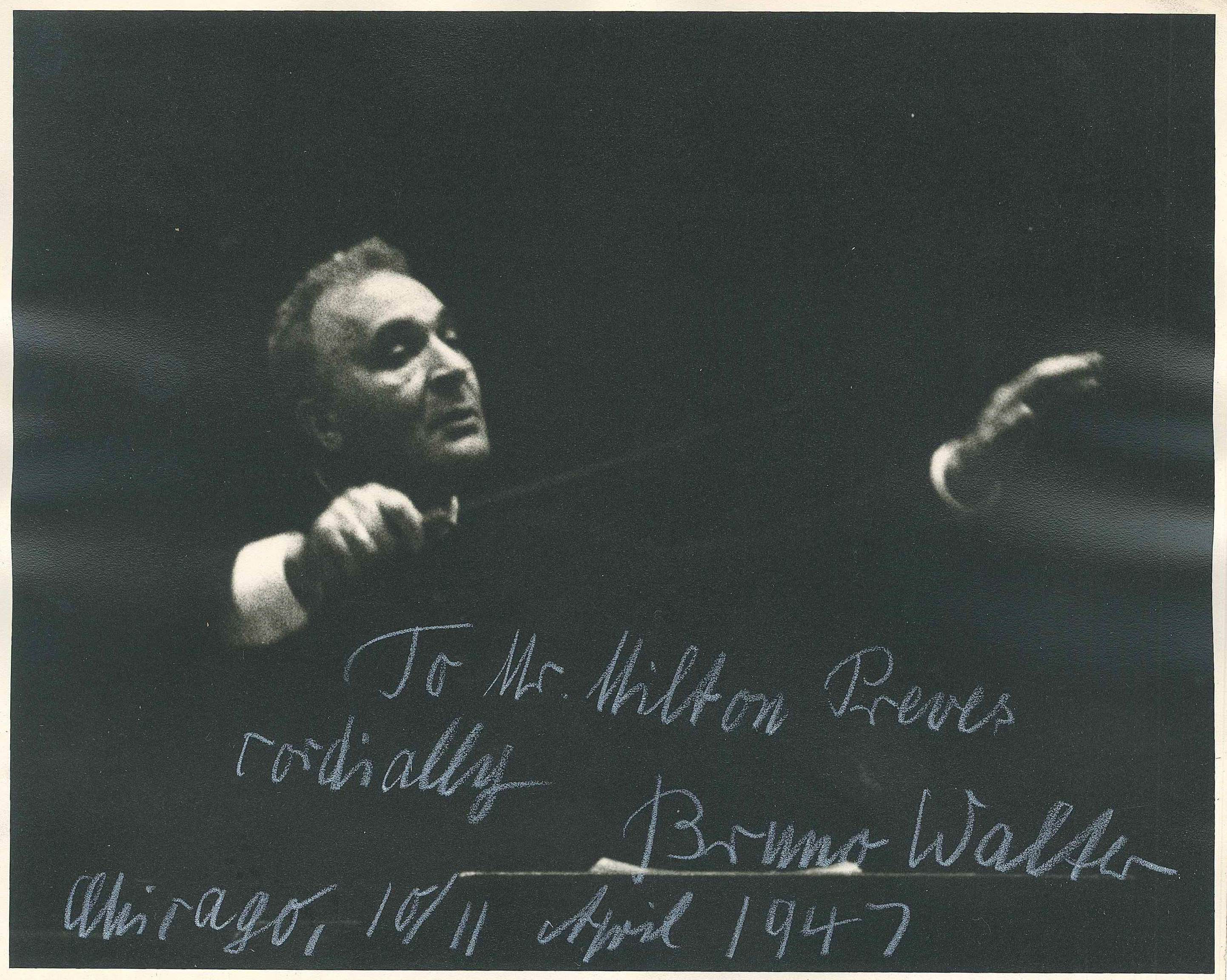


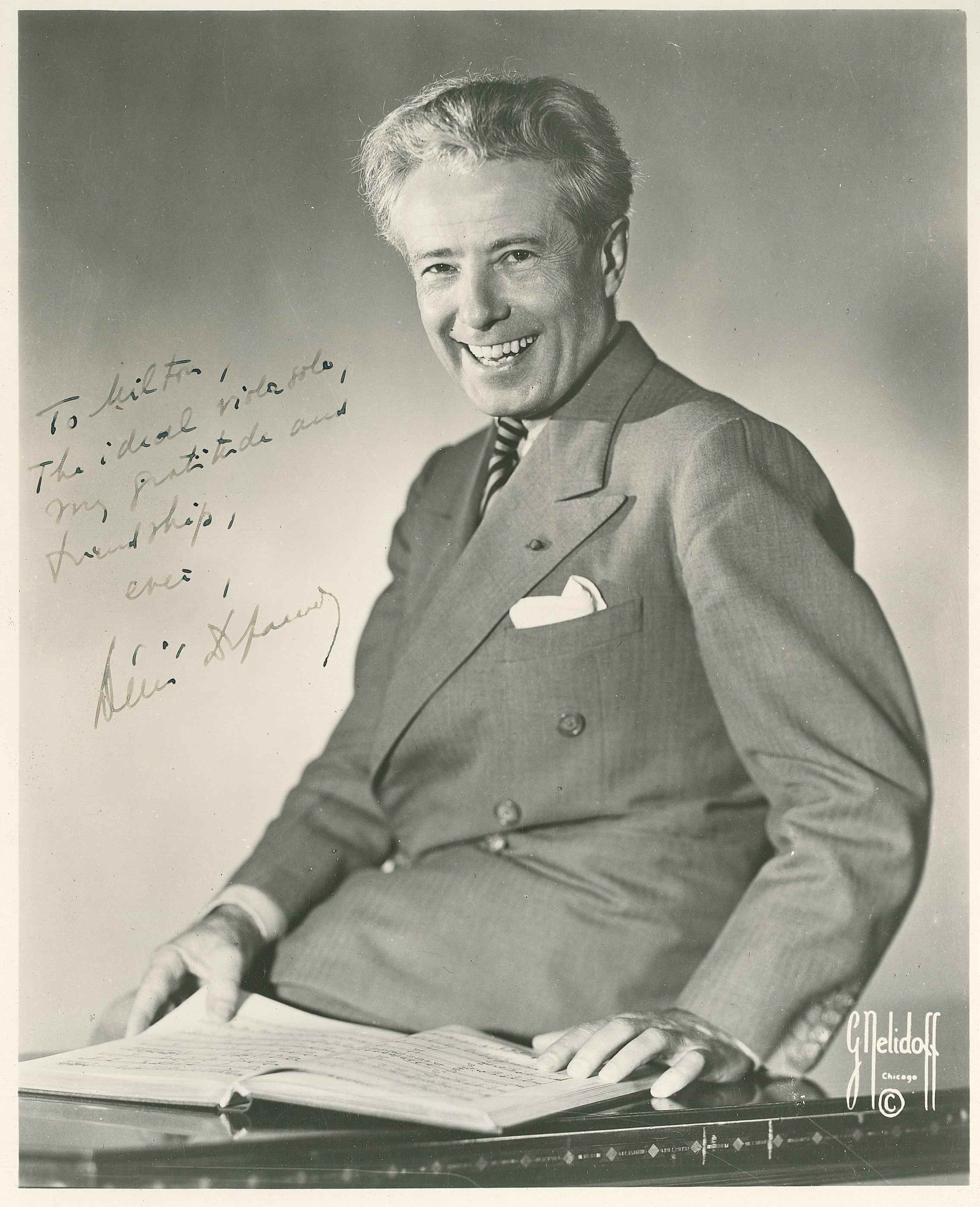


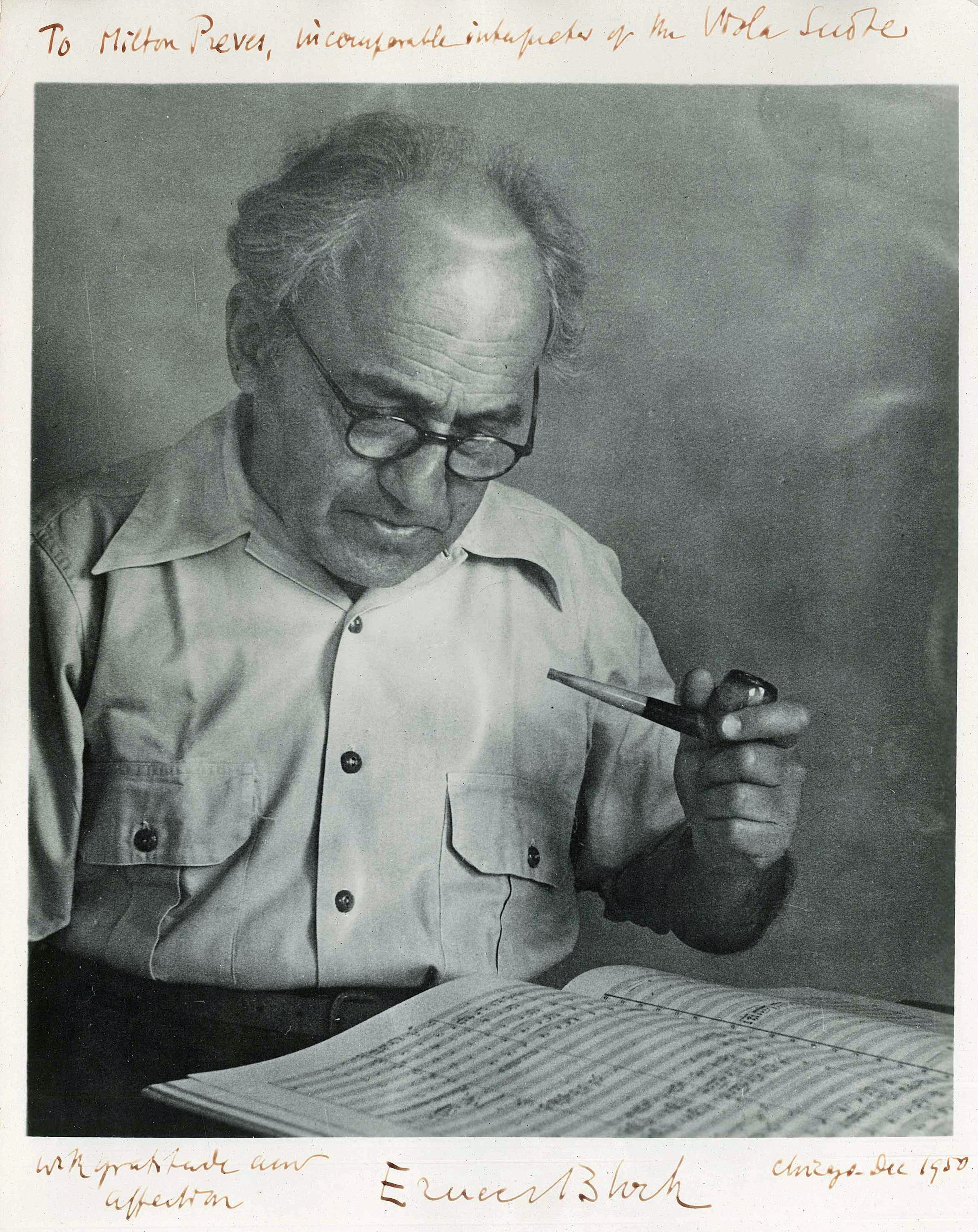

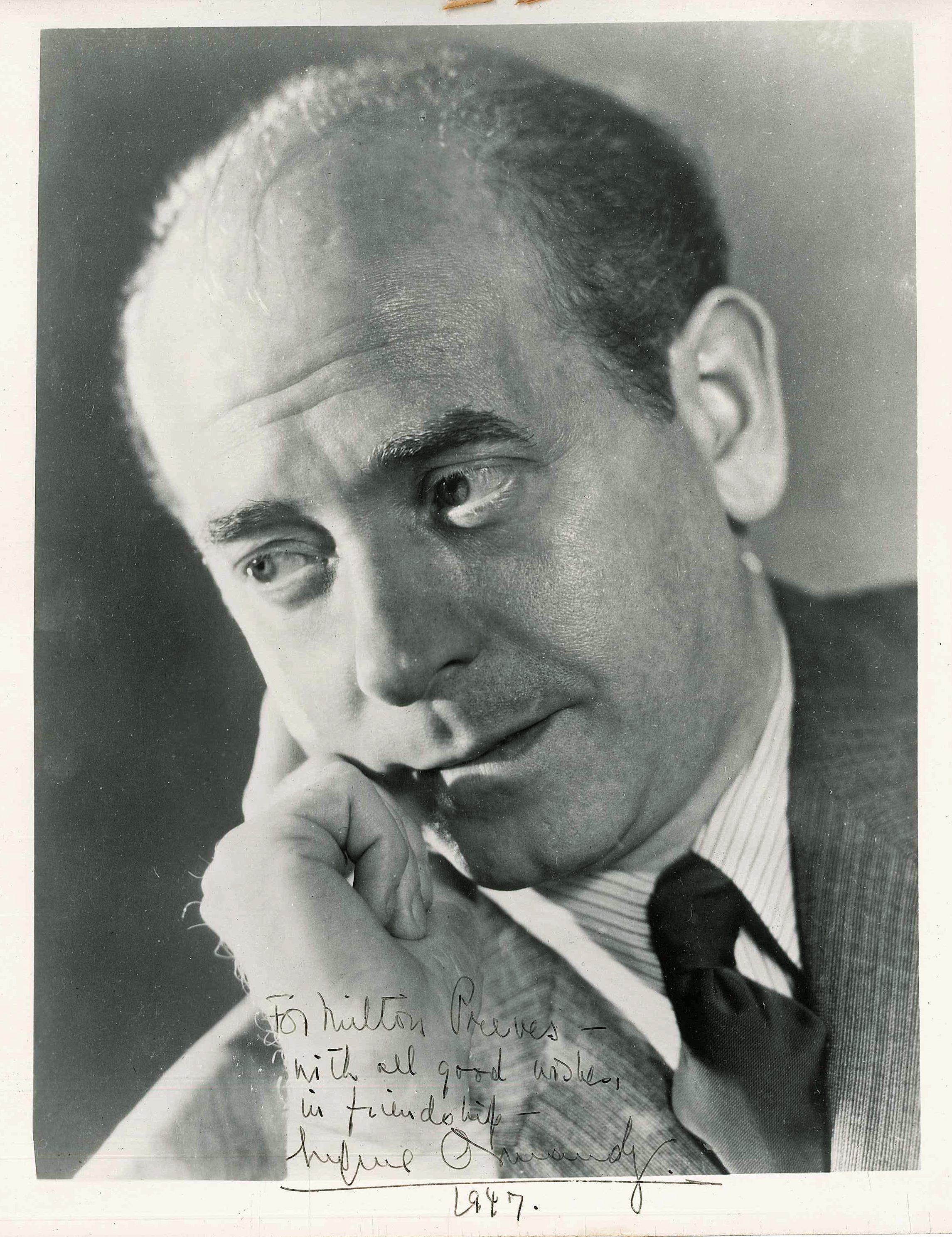
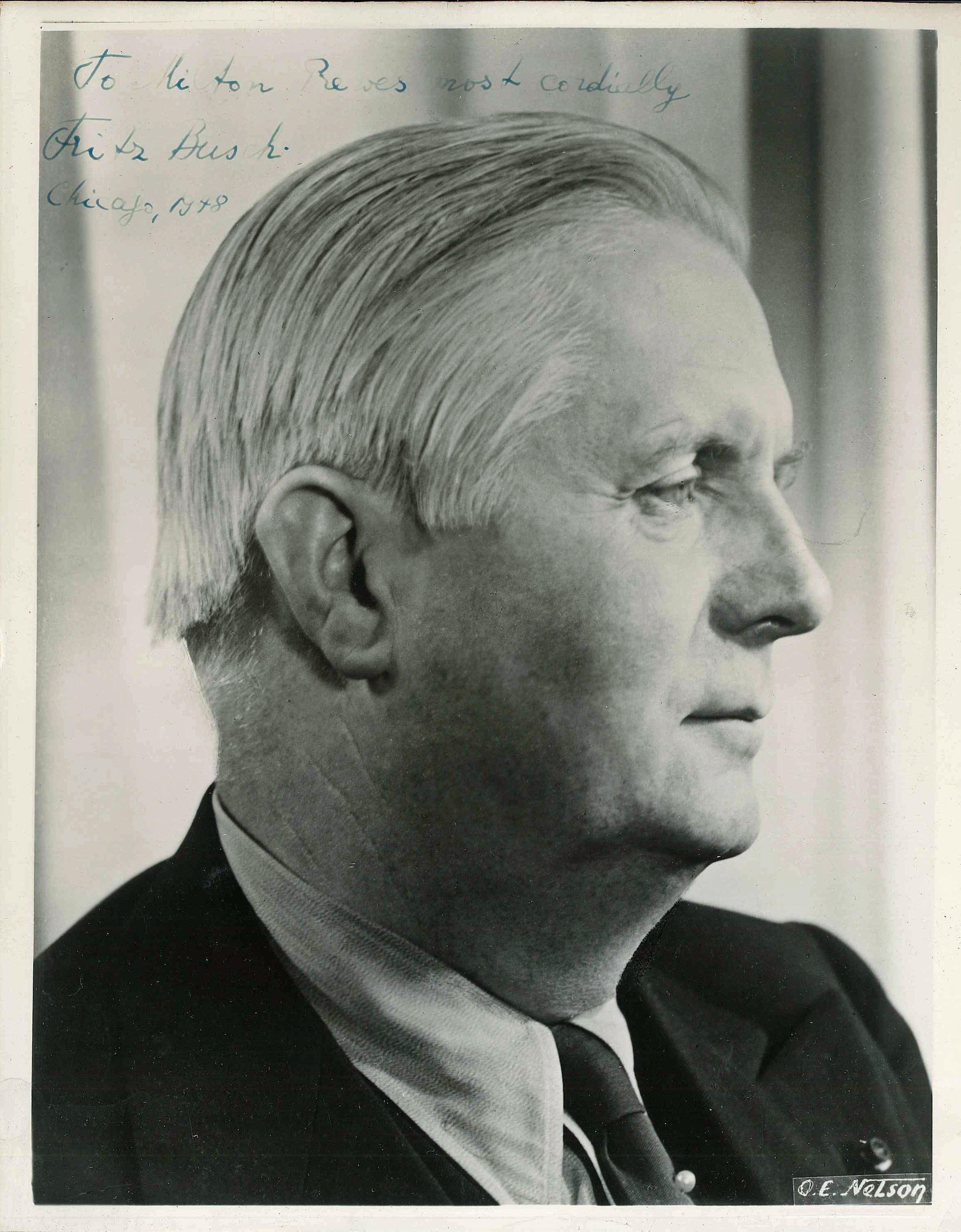


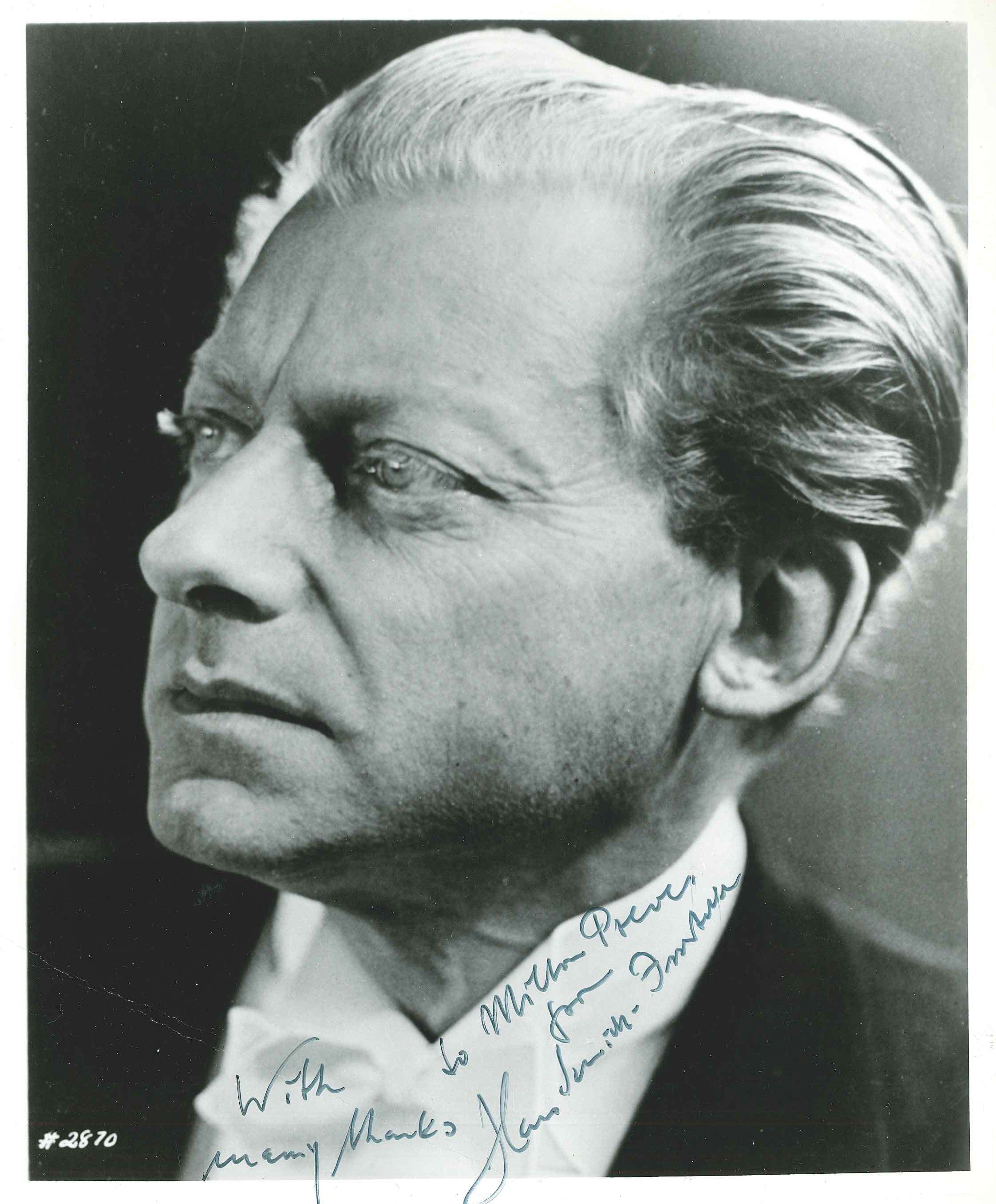



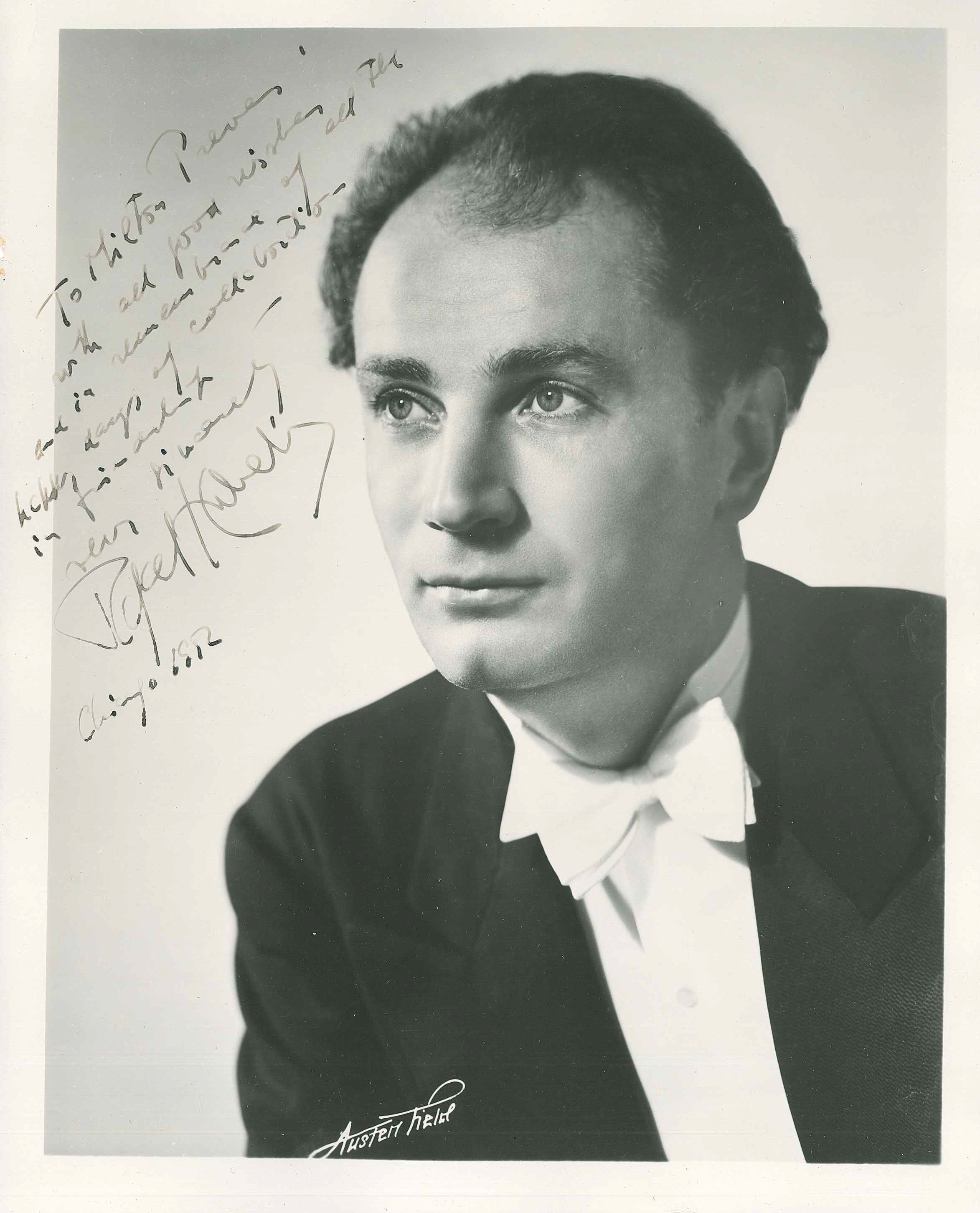

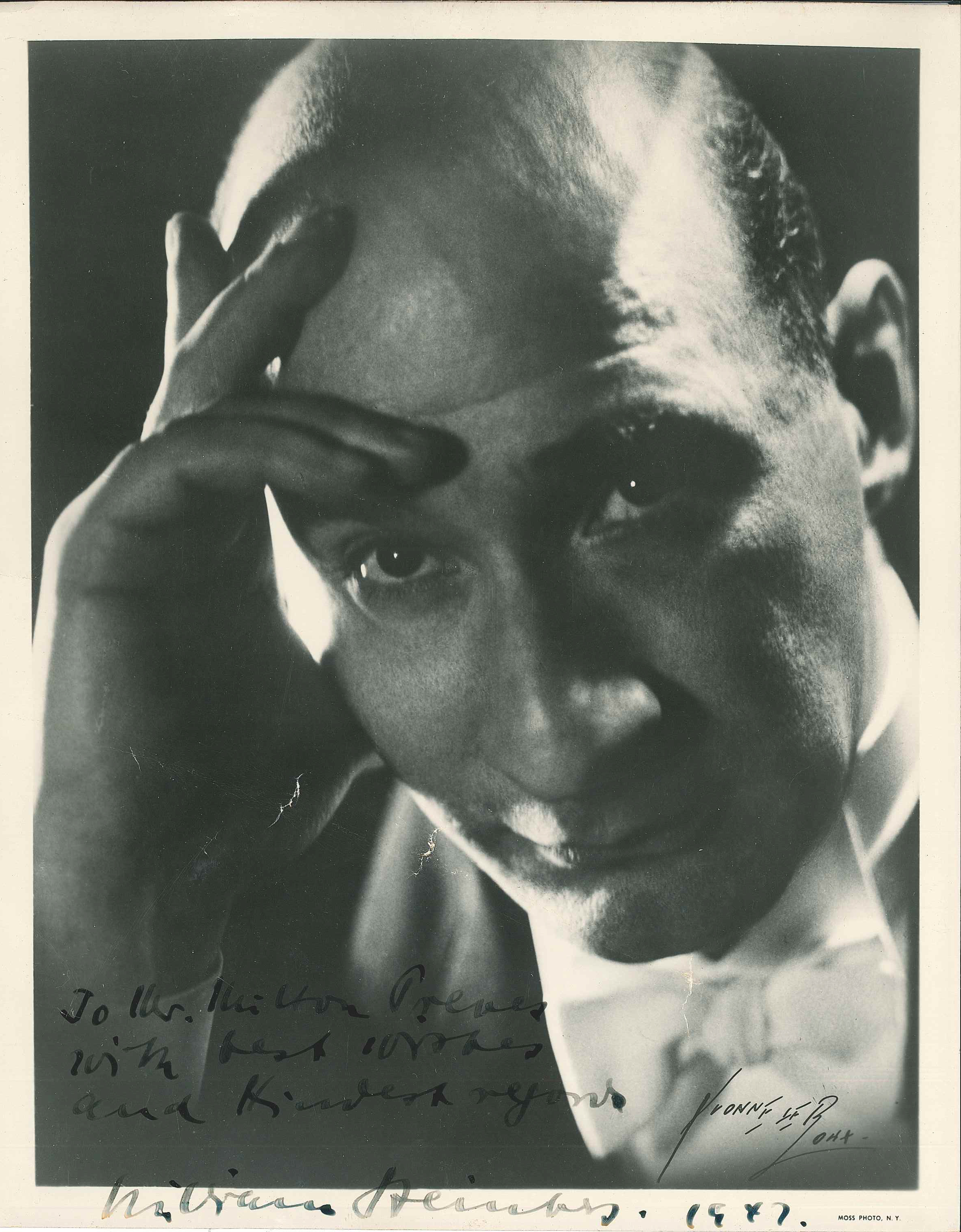
In October 1984, on the occasion of Milton Preves’s fiftieth anniversary with the Chicago Symphony Orchestra, fellow viola Isadore Zverow (1909–1999) composed this poem to honor his colleague:
It’s no mean feat, without retreat
To hold the forte so long,
To stroke and pluck in cold and heat—
All to produce a song.
Toward music bent, with single intent,
Unyielding dedication,
You of yourself so gladly lent
Your valued perspiration.
You sat and played and marked and bowed
And sometimes e’en reproached
And sometimes we squirmed (just a bit)
We didn’t wanna be coached.
And yet whene’er the chips were down
Throughout these fifty anna,
Your steadfast presence was a crown
Aiming at Nirvana.
This article also appears here.
With the Chicago Symphony Orchestra, no one has performed Schumann’s Piano Concerto more than Fannie Bloomfield Zeisler.
Born in Austria in 1863, Fannie Blumenfeld and her family immigrated to the United States in 1867 and settled in Chicago. She began piano studies at the age of six and gave her first concert on February 26, 1875. Encouraged by the Russian pianist Anna Essipoff, Blumenfeld returned to Vienna in 1878, where she began studies with Theodor Leschetizky. Shortly after returning to the U.S. in 1883—and anglicizing her name to Bloomfield—she auditioned for Theodore Thomas, then the music director for the New York Philharmonic as well as his eponymous Theodore Thomas Orchestra. It was too late to hire her for his upcoming seasons, but, inspired by her playing, Thomas provided letters of recommendation to help her secure other engagements.
Bloomfield made her professional debut in Chicago’s Central Music Hall on January 11, 1884, performing the first movement of Adolf von Henselt’s Piano Concerto in F minor under the baton of one of her first teachers, Carl Wolfsohn. In the Chicago Tribune, the reviewer described her performance with “A firm but at the same time delicate touch, a technique which overcomes the greatest difficulties without apparent effort, and an intelligent mastery over the mechanism of her instrument were the characteristics of her playing, which made themselves felt before she had finished a small portion of her task. Every note received its due. . . . It was a great treat, Miss Bloomfield’s playing, and one not soon to be forgotten.”

Bloomfield’s debut in New York occurred the following year, on February 1, 1885, under Frank Van der Stucken and his orchestra, again with Henselt’s Piano Concerto. In October of that year, she married Sigmund Zeisler (who later served on the defense counsel for the anarchists responsible for the onset of the Haymarket Square riot), and the couple had three sons.
Zeisler made her debut with the Chicago Orchestra during the ensemble’s first season, at the Auditorium Theatre on March 25 and 26, 1892. “The solo part in [Chopin’s second] concerto was played by Mrs. Fannie Bloomfield Zeisler, a Chicago artist who is heard but too rarely in local concerts,” wrote the reviewer in the Chicago Tribune. “Few piano performances heard in the Auditorium have possessed as high artistic finish and true musicianly qualities as did that accorded Chopin’s concerto last evening by Mrs. Zeisler. There have been performances more brilliant, performances more impressive in their breadth and power, but none have revealed greater refinement of style and clearer, truer conception than did this.”
Later that spring, Zeisler joined Thomas and the Orchestra on tour to perform three concerts in Omaha, two in Louisville, and one in Kansas City, Missouri; her repertoire included Chopin’s Second, Rubinstein’s Fourth, and Saint-Saëns’s Fourth concertos.
The following season, she appeared with the Orchestra on a pair of subscription concerts in December and on tour on five occasions, including concerts in Pittsburgh and Buffalo in April that included the ensemble’s first performances of Schumann’s Piano Concerto. Soon thereafter, Zeisler was one of only two pianists—along with Ignace Paderewski—chosen by Thomas to perform with the Orchestra at the World’s Columbian Exposition. On June 9, 1893, she appeared in an all-Schumann concert (honoring the composer’s birthday) that included the Manfred Overture, Third Symphony, and the Piano Concerto. “Mme. Zeisler proved herself,” according to the Chicago Tribune, giving “a performance in every respect admirable and satisfying [lending] charm and poetry.”
Over the next thirty years, Zeisler was a frequent and favorite soloist with the Orchestra, performing not only Schumann’s concerto, but also works by Beethoven, Chopin, Grieg, Henselt, Liszt, Mendelssohn, Moszkowski, Mozart, Rubinstein, Saint-Saëns, Tchaikovsky, and Weber.
On February 25, 1925, Fannie Bloomfield Zeisler appeared with Frederick Stock and the Chicago Symphony Orchestra—and before the public—one last time, in a concert celebrating her fiftieth year as a concert artist. The program included Beethoven’s Andante favori, Chopin’s Second Piano Concerto, and her eighth performance with the CSO of Schumann’s Piano Concerto. “You might have closed your eyes and been willing to swear that an artist in the first flush of maturity, with intensively cultivated powers and enormous flair for major piano works was playing,” wrote the critic in the Chicago Tribune. “It was the seal on an honorable and highly honored career. Mrs. Zeisler is as sincere an artist as ever appeared before the public. [Her honesty] shone through, every note she played, just as it has always shone whenever she played. And a capacity audience was present to testify to the esteem in which the fine sincerity of a fine artist is held.” She died in Chicago on August 21, 1927.
Portions of this article appear in the May 19, 20, 21, and 22, 2022, program book; and the article also appears here.
“What could come after [the Fifth Symphony]?” wrote Frederick Stock, the Chicago Symphony Orchestra‘s second music director, in Talks About Beethoven’s Symphonies. “The subtlety of Beethoven’s imagination found an answer in due time, and in his Sixth Symphony, the Pastoral, we find his thoughts expressed in a new form. Even though other composers before him and in his time had attempted to write program music, Beethoven was the first whose efforts in this direction proved to be a lasting achievement. . . . His was a poetic conception of nature’s grandeur and beauty, a faithful interpretation of her inward significance, cast in the most perfect of musical forms, the symphony.”

“Our familiar picture of Beethoven, cross and deaf, slumped in total absorption over his sketches, doesn’t easily allow for Beethoven the nature-lover,” writes writes CSOA scholar-in-residence and program annotator Phillip Huscher. “But he liked nothing more than a walk in the woods, where he could wander undisturbed, stopping from time to time to scribble a new idea on the folded sheets of music paper he always carried in his pocket. ‘No one,’ he wrote to Therese Malfati two years after the premiere of the Pastoral Symphony, ‘can love the country as much as I do. For surely woods, trees, and rocks produce the echo which man desires to hear.’ They’re all here in his Sixth Symphony.”
Founder and first music director Theodore Thomas first led the Chicago Orchestra in Beethoven’s Sixth Symphony on March 2 and 3, 1894, at the Auditorium Theatre.
Sixth music director Fritz Reiner led the Orchestra’s first recording of Beethoven’s Sixth Symphony on April 8 and 10, 1961, in Orchestra Hall. For RCA, Richard Mohr was the producer and Lewis Layton was the recording engineer.
Sir Georg Solti and the Chicago Symphony Orchestra and Chorus first recorded Beethoven’s nine symphonies between May 1972 and September 1974 for London Records. The recordings were ultimately released as a set (along with three overtures: Egmont, Coriolan, and Leonore no. 3); that set won the 1975 Grammy Award for Classical Album of the Year from the National Academy of Recording Arts and Sciences. The Sixth Symphony was recorded at the Sofiensaal in Vienna on September 10, 1974. Ray Minshull was the recording producer, and Kenneth Wilkinson, and James Lock were the balance engineers.
Between September 1986 and January 1990, Solti and the Orchestra and Chorus recorded the complete Beethoven symphonies a second time, again for London Records; and again, the recordings were ultimately released as a set (along with two overtures: Egmont and Leonore no. 3). The Sixth Symphony was recorded in Orchestra Hall on May 9, 10, 14, and 16, 1988. Michael Haas was the recording producer and Stanley Goodall was the balance engineer.
This article also appears here.
















































